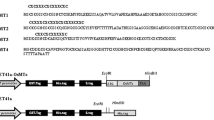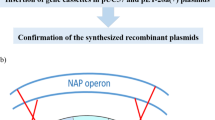Abstract
The mercury transporter, merT, from Cupriavidus metallidurans was cloned into pRSET-C and expressed in various E. coli hosts. Expression of merT gene failed in common expression hosts like E. coli BL21(DE3), E. coli BL21(DE3)pLysS and E. coli GJ1158 due to expression induced toxicity. The protein was successfully expressed in E. coli C43(DE3) as inclusion bodies. The inclusion bodies were solubilized with Triton X-100 detergent. The detergent solubilized protein with N-terminal His-tag was purified in a single-step by immobilized metal affinity chromatography with a yield of 8 mg l−1.


Similar content being viewed by others
References
Barkay T, Miller SM, Summers AO (2003) Bacterial mercury resistance from atoms to ecosystems. FEMS Microbiol Rev 27:355–384
Drew D, Fröderberg L, Baars L, de Gier JW (2003) Assembly and overexpression of membrane proteins in Escherichia coli. Biochim Biophys Acta 1610:3–10
Kado CI, Liu ST (1981) Rapid procedure for detection and isolation of large and small plasmids. J Bacteriol 145:1365–1373
Kiyono M, Pan-Hou H (2006) Genetic engineering of bacteria for environmental remediation of mercury. J Health Sci 52:199–204
Mergeay M, Nies D, Schlegel HG, Gerits J, Charles P, Gijsegem VF (1985) Alcaligenes eutrophus is a facultative chemolithotroph with plasmid-bound resistance to heavy metals. J Bacteriol 162:328–334
Omura T, Kiyono M, Pan-Hou H (2004) Development of specific and sensitive bacteria sensor for detection of mercury at picomolar levels in environment. J Health Sci 50:379–383
Portoa JIR, Cleusa SOA, Feldberga E (2005) Mutagenic effects of mercury pollution as revealed by micronucleus test on three Amazonian fish species. Environ Res 97(3):287–292
Rossy E, Olivier S, Lascouxc D, Lemairec D et al (2004) Is the cytoplasmic loop of merT, the mercuric ion transport protein, involved in mercury transfer to the mercuric reductase? FEBS Lett 575:86–90
Serre L, Rossy E, Pebay-Peyroula E, Cohen-Addad C, Coves J (2004) Crystal structure of the oxidized form of the periplasmic mercury-binding protein merP from Ralstonia metallidurans. J Mol Biol 339(1):161–171
Spry DJ, Wiener JG (1991) Metal bioavailability and toxicity to fish in low-alkalinity lakes: a critical review. Environ Pollut 71:243–304
Steele RA, Opella SJ (1997) Structures of the reduced and mercury-bound forms of MerP, the periplasmic protein from the bacterial mercury detoxification system. Biochemistry 36(23):6885–6895
Stroud RM, Choe S, Holton J, Kaback HR et al (2009) 2007 Annual progress report synopsis of the Center for Structures of Membrane Proteins. J Struct Funct Genomics 10(2):193–208
Summer AO, Jackson WJ (1982) Polypeptides encoded by the mer operon. J Bacteriol 149(2):479–487
Wagner S, Baars L, Ytterberg AJ, Klussmeier A et al (2007) Consequences of membrane protein over-expression in Escherichia coli. Mol Cell Proteomics 6:1527–1550
Wagner S, Klepsch MM, Schlegel S, Appel A et al (2008) Tuning Escherichia coli for membrane protein over-expression. Proc Natl Acad Sci 105:14371–14376
Acknowledgement
This study was supported by grants from Council of Scientific and Industrial Research (CSIR), India.
Author information
Authors and Affiliations
Corresponding author
Additional information
Purpose of work: The objective of this work was to overexpress mercury transporter (merT) protein and to circumvent the expression induced toxicity in E. coli. We further investigated the optimum detergents and solubility conditions required for single-step purification of merT by immobilized metal affinity chromatography.
Electronic supplementary material
Below is the link to the electronic supplementary material.
Rights and permissions
About this article
Cite this article
Senthil, K., Gautam, P. Expression and single-step purification of mercury transporter (merT) from Cupriavidus metallidurans in E. coli . Biotechnol Lett 32, 1663–1666 (2010). https://doi.org/10.1007/s10529-010-0337-2
Received:
Accepted:
Published:
Issue Date:
DOI: https://doi.org/10.1007/s10529-010-0337-2




